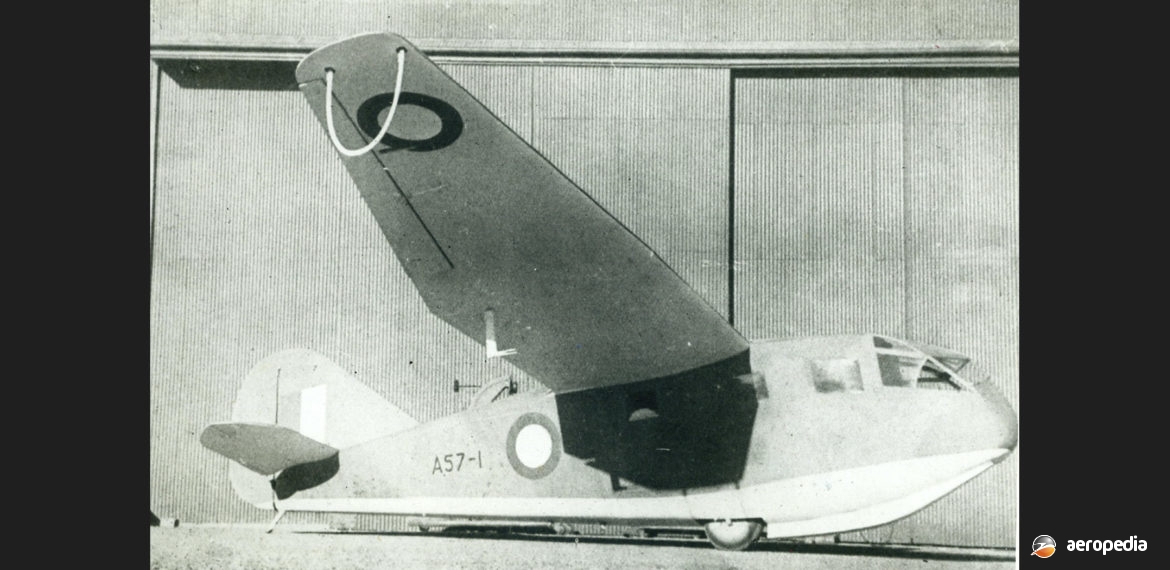Photograph:
de Havilland DHA G.1 A57-1 at Laverton, VIC circa 1943 (RAAF Museum)
Country of origin:
Australia
Description:
Military transport glider
Power Plant:
Specifications:
- Wingspan: 15.39 m (50 ft 6 in)
- Length: 10.05 m (33 ft)
- Height: 2.39 m (7 ft 10 in)
- Wing area: 30.84 m² (332 sq ft)
- Max diving speed: 322 km/h (200 mph)
- Max speed free: 298 km/h (185 mph)
- Max towing speed: 209 km/h (130 mph)
- Stalling speed: 77 km/h (48 mph)
- Empty weight: 658 kg (1,450 lb)
- Loaded weight: 1,474 kg (3,250 lb)
History:
In March 1942 the Australian Department of Air published a requirement for 126 troop transport gliders for the RAAF, and a specification was issued for a seven-seat prototype of a glider for development and testing. The 5th floor of the Bradford Cotton Mills Building at Camperdown, NSW was selected for design and construction. The chief designer was Martin Warner.
In April 1942 the RAAF authorised the construction of a second DHA G.1 for military trials, the two aircraft becoming known as the EG.1 and EG.2. The gliders were a high-wing cantilever monoplane with a plywood covered wing. The windscreen and window frames of the de Havilland DH.84 Dragon were used. Control surfaces were fabric covered and the undercarriage was a single wheel.
Flight testing of the EG.1 began on 14 June 1942 after assembly at RAAF Richmond, NSW the tow aircraft being a Fairey Battle. The EG.2 after completion was assembled at Mascot, NSW and flight tests were made there. On 5 October 1942 the EG.1 was towed from RAAF Richmond to RAAF Laverton, VIC where it received a new serial A57-1001, being joined on 17 November 1942 by the EG.2 A57-1002. Reports were prepared relating to the estimated performance of the glider being towed behind the Bristol Beaufort VIII and the Lockheed Hudson III. The two glider aircraft were attached to SPDF and No 1 Aircraft Performance Unit (APU), and later to No 5 Aircraft Depot (AD) at Cootamundra, NSW where they were eventually stored. On 18 December 1947 the gliders were transferred to the Department of Aircraft Production. However, the type did not go into production in large numbers due to the availability, it is said, of the Douglas Dakota and the Waco CG-4A troop glider, which could accommodate 15 troops.
Some six DHA G.2 gliders were built for the RAAF to specification 5/42, these having a three-piece wing in lieu of the single piece in order to permit easier transportation to operational areas. These machines A57-1 to A57-6 were built at the Slingo & Williams building, which had been a toy factory, and were assembled at Mascot, NSW. Tests were performed behind Fairey Battles by No 3 Communications Flight. They differed in having a 15.39 m (50 ft 6 in) wingspan in lieu of the 17.99 m (59 ft) of the prototypes.+
In July 1943 A57-2 to A57-6 were delivered to No 2 Aircraft Depot at RAAF Richmond, and in August they were transferred to No 1 Air Observers School at Evans Head, NSW for storage, where they remained, sometimes being put to various uses, ie A57-4 becoming an instructional airframe; A57-5 going to the CSIR-DA; and A57-3 occasionally being flown behind Douglas C-47 Dakotas from Richmond up until the 1950s.
In June 1946 it was decided to fit a Griffith type suction wing to A57-1, the machine to be known as the GLAS II, the work to be performed by the Aeronautical Research Laboratories (formerly CSIR-DA), the DAP Beaufort Division, and the RAAF. Conversion took place at the Fishermens Bend, VIC facility of the Government Aircraft Factory (GAF). The wing had a span of 14.88 m (48 ft 9 in). A 72 kw (96 hp) Ford V-8 Mercury 59A engine was installed in the fuselage to drive the centrifugal blower to suck the boundary air from the wing through very close tolerance full-span slots. Final assembly took place at Laverton.
Early tests comprised being tethered behind the slipstream of an Avro Lincoln B.Mk 30. Test flights behind a Dakota commenced on 26 October 1948. Some 49 flights in all were made and most problems were overcome. However, it was found that foreign bodies adhered to the wing, ie insects, and these created a contaminated airflow. Development of the design was considered, in particular the GAD-4 suction-wing glider, and a 72 passenger all-wing airliner, but these were never built.
Eventually, on 17 December 1952, A57-1 was offered for disposal and the type became extinct.

